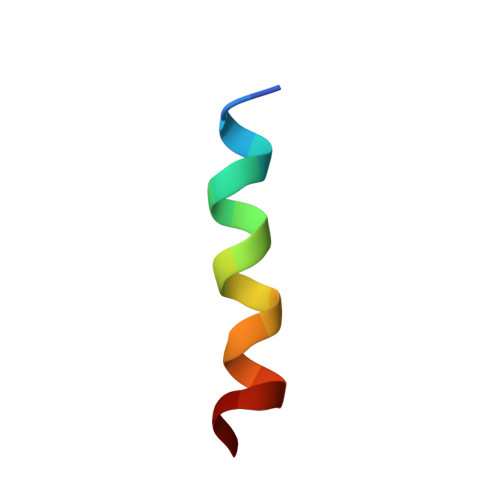Unique helical conformation of the fourth cytoplasmic loop of the CB1 cannabinoid receptor in a negatively charged environment.
Grace, C.R., Cowsik, S.M., Shim, J.Y., Welsh, W.J., Howlett, A.C.(2007) J Struct Biol 159: 359-368
- PubMed: 17524664
- DOI: https://doi.org/10.1016/j.jsb.2007.04.004
- Primary Citation of Related Structures:
2B0Y - PubMed Abstract:
The proximal portion of the C-terminus of the CB(1) cannabinoid receptor is a primary determinant for G-protein activation. A 17 residue proximal C-terminal peptide (rodent CB1 401-417), the intracellular loop 4 (IL4) peptide, mimicked the receptor's G-protein activation domain. Because of the importance of the cationic amino acids to G-protein activation, the three-dimensional structure of the IL4 peptide in a negatively charged sodium dodecyl sulfate (SDS) micellar environment has been studied by two-dimensional proton nuclear magnetic resonance (2D (1)H NMR) spectroscopy and distance geometry calculations. Unambiguous proton NMR assignments were carried out with the aid of correlation spectroscopy (DQF-COSY and TOCSY) and nuclear Overhauser effect spectroscopy (NOESY and ROESY) experiments. The distance constraints were used in torsion angle dynamics algorithm for NMR applications (DYANA) to generate a family of structures which were refined using restrained energy minimization and dynamics. In water, the IL4 peptide prefers an extended conformation, whereas in SDS micelles, 3(10)-helical conformation is induced. The predominance of 3(10)-helical domain structure in SDS represents a unique difference compared with structure in alternative environments, which can significantly impact global electrostatic surface potential on the cytoplasmic surface of the CB(1) receptor and might influence the signal to the G-proteins.
Organizational Affiliation:
Post-Graduate Department of Physics, Christ College, Bangalore 560 029, India.














